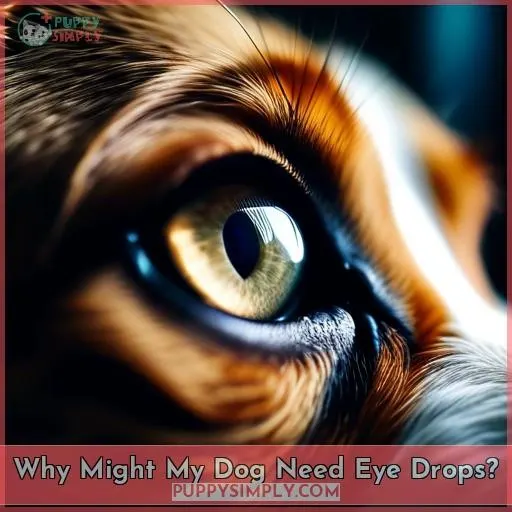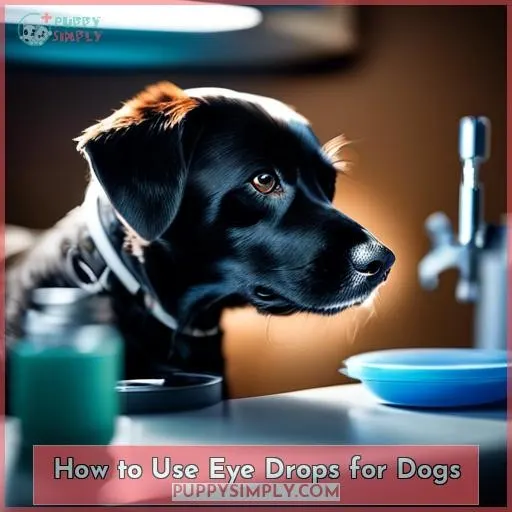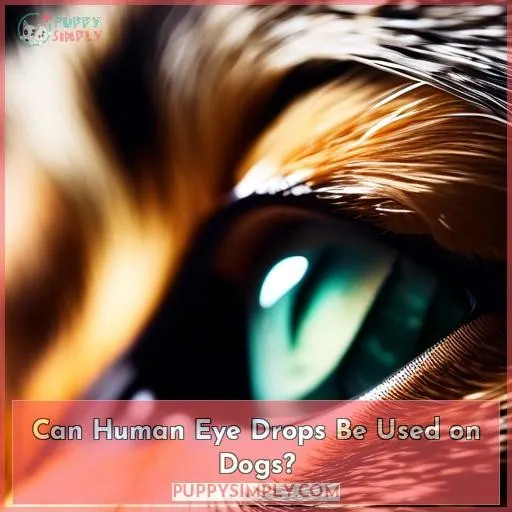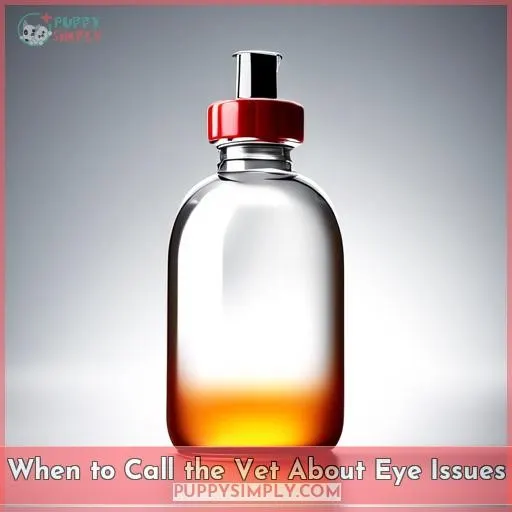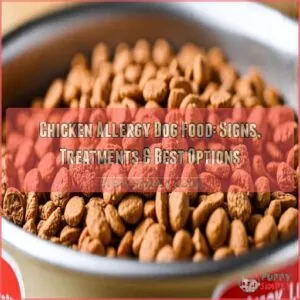This site is supported by our readers. We may earn a commission, at no cost to you, if you purchase through links.
 You’re worried about your furry friend. Those cloudy eyes and bumping into furniture are telltale signs of canine cataracts.
You’re worried about your furry friend. Those cloudy eyes and bumping into furniture are telltale signs of canine cataracts.
Rest assured, there are options, from cataract eye drops to surgery. While no medication has been scientifically proven to reverse cataracts in dogs, emerging research shows promise. Some pups respond well to anticataract drops, regaining vision and avoiding surgery.
Work closely with your vet, monitor progress, and continue providing excellent care. Cataracts don’t mean automatic blindness for your dog – he can live a long, joyous life.
You’ve got this! With compassion and persistence, your dog will be wagging his tail again soon.
Table Of Contents
- Key Takeaways
- What Are Canine Cataracts?
- Can You Treat Cataracts Without Surgery?
- Why Might My Dog Need Eye Drops?
- Nutri Vet Dog Eye Cleanser
- Optixcare Dog Cat Eye Lubricating Gel
- Vetericyn Pet Eye Wash
- Vets Preferred Advanced Eye Wash for Dogs Bottle
- Terramycin Ophthalmic Ointment Dogs Cats Horses
- Ciprofloxacin Ophthalmic Solution
- Tobramycin Ophthalmic Solution Generic
- Ketorolac Tromethamine Ophthalmic Solution Generic
- Prednisolone Acetate Ophthalmic Suspension
- Dexamethasone Eye Drops
- How to Use Eye Drops for Dogs
- Can Human Eye Drops Be Used on Dogs?
- Tips for Preventing Cataracts in Dogs
- When to Call the Vet About Eye Issues
- Frequently Asked Questions (FAQs)
- How often should I apply the eye drops for my dog’s cataracts?
- What should I do if my dog won’t let me put eye drops in their eyes?
- Do these eye drops have any side effects I should watch out for in my dog?
- How long will it take before I notice an improvement in my dog’s vision after starting the eye drops?
- Should I continue using the eye drops after my dog’s cataract surgery?
- Conclusion
Key Takeaways
- Emerging research shows promise for anticataract eye drops to help dogs regain vision and avoid surgery.
- Work closely with your veterinarian to monitor your dog’s progress and adjust treatment if anticataract eye drops are prescribed.
- Protect your dog’s eyes from UV exposure, injuries, and irritants to support optimal eye health.
- Schedule regular veterinary exams to catch eye issues early when most treatable, and monitor eye drop dosage and effectiveness.
What Are Canine Cataracts?
You’ve probably noticed your aging dog’s eyes looking cloudy and bluish-gray. This condition called canine cataracts involves protein clumping in the lens, reducing light intake and causing poor vision.
Common signs of canine cataracts are pupil cloudiness, clumsiness, and reluctance to go out at night. Cataracts usually start small but can progress to blindness if left untreated. Common causes of cataracts in dogs are old age, diabetes, genetics, and eye injury.
Veterinarians diagnose canine cataracts through a thorough eye exam using an ophthalmoscope and other tools.
Signs of Cataracts
You’ll notice your dog’s vision getting cloudier as cataracts develop, making it harder for them to see clearly or in low light. Their eyes may take on a gray, blue, or white hazy appearance. Your elderly dog may start having trouble finding toys, following moving objects, seeing at night, navigating stairs, or responding to hand signals.
Causes
Unfortunately, your little buddy’s cloudy peepers could stem from aging, genetics, or diseases like diabetes. Cataracts in dogs often develop from aging changes, inherited genes, and medical conditions like diabetes.
Monitoring your pup’s health, providing wholesome nutrition, limiting chemical exposures, and catching problems early allows their eyes to stay clear and bright well into their senior years.
Diagnosis
Veterinarians examine your dog’s eyes with a light to diagnose cataracts by the cloudiness blocking vision. During the exam, they look for opaque lesions on the lens that impair sight. Early detection allows for lifestyle changes to potentially slow progression.
Regular eye exams help vets diagnose cataracts before they mature and cause total blindness.
Can You Treat Cataracts Without Surgery?
As an owner, you may have heard about lanosterol eye drops as a potential non-surgical treatment for your dog’s cataracts. However, keep in mind that while eye drops show promise in studies, surgery remains the only definitive treatment proven to effectively restore vision impaired by cataracts in dogs.
Lanosterol Eye Drops
Seeking your vet’s advice before trying lanosterol eye drops on your pup could determine if they’re an appropriate cataract treatment option. Regular eye exams, limiting UV exposure, and dietary changes like antioxidant supplements may help slow cataract progression in dogs prone to this condition.
Still, surgery remains the only proven way to restore vision once cataracts become severe. While lanosterol drops aim to dissolve proteins clouding the lens, research on their effectiveness is limited.
Limitations of Nonsurgical Options
You’ll want to limit expectations since no proven eye drops dissolve dog cataracts yet, hon. While some experimental ingredients like lanosterol show promise in counteracting aging lens proteins, their limited effectiveness means delaying surgery risks irreversible vision loss.
Consulting your vet is key for assessing alternatives, but diet and drops merely delay cataract progression – none dissolve developed cataracts. Safeguarding your pup’s eye health means promptly treating abnormalities, but managing expectations about unproven ingredients’ absorption and cataract-dissolving claims is important.
Prioritizing your dog’s quality of life should guide decisions about surgery versus unproven alternatives.
Why Might My Dog Need Eye Drops?
Lots of conditions require eye drops for your dog. Bacterial or viral infections like pink eye, allergies triggering itchiness and redness, dry eye causing lack of moisture and irritation, or corneal ulcers on the eye’s surface call for medication.
Drops treat infections, reduce inflammation, lubricate, and promote healing so your pup’s peepers stay happy and healthy.
Infections
If an infection is causing your puppy’s eye troubles, you will likely need antibiotic drops to clear it up. Bacterial and viral infections manifest through redness, discharge, and irritation. Follow your veterinarian’s prescription for the proper drops to apply directly in the affected eye(s) to soothe and heal.
Allergies
Your pup’s eyes get red and itchy because of allergies. Allergic reactions can cause inflammation, discharge, and discomfort. Gentle saline drops provide moisture, flush irritants, and soothe itching. Consult your veterinarian for recommended eye care.
Monitor for worsening and discuss medication if over-the-counter drops don’t provide relief.
Dry Eye
Cyclosporine eye drops can help treat dry eye in dogs. The anti-inflammatory medication increases tear production and lubricates irritated eyes. Regular use keeps eyes moisturized, reducing inflammation and discomfort. Consult your veterinarian about using these prescription drops to manage dryness and restore comfort.
Corneal Ulcers
Having constantly flowing tears to protect your pup’s tender peepers could save their sight, so keep their eyes moist before infections spread. Recurring eye issues need remedies beyond antibiotics to avoid surgery complications and costs.
Compare prevention strategies like allergy eye drops, safe baths, and protecting eyes to stop corneal ulcers from developing.
Nutri Vet Dog Eye Cleanser
The Nutri Vet Dog Eye Cleanser you mentioned is a great gentle rinse that can really help clean your pup’s eyes, reduce stains, and clear up discharge. This non-irritating formula is specially designed for dogs and safe for regular use.
Customers report the Eye Cleanser works well for reducing tear stains, soothing red or irritated eyes, and removing gunky buildup.
Daily use can help keep your dog’s eyes clean and comfortable. While the bottle design makes application a bit messy, the solution itself seems gentle and effective according to reviews. Using an eye rinse allows you to avoid frequent use of eye drops, which can be harsh, or supplements added to food.
For dogs prone to eye issues, this can be a handy way to maintain eye health and appearance. Be sure to follow all label directions and talk to your vet if your pup has any abnormal eye symptoms. With regular use, the Nutri Vet Cleanser could be a good option for keeping your dog’s eyes clean and clear.
- Gentle, non-irritating for dogs’ eyes
- Clears stains, discharge, redness
- Preferred to drops or supplements
- Messy application
- Bottle design makes dispensing tricky
- May require daily long-term use
Optixcare Dog Cat Eye Lubricating Gel
Put the gel in her eyes and let it soothe your pup’s peepers. Optixcare Eye Gel provides a soothing barrier of lubrication to protect dry, irritated eyes in canines. The easy-to-apply carbomer gel forms a smooth film over the surface of the eye, mimicking natural tear film.
Research shows the hyaluron in Optixcare Eye Gel helps retain moisture and relieves discomfort.
This veterinarian-recommended product is ideal for dogs with chronic dry eye, allergies, or injuries. The gel consistency makes it simple to administer – just squeeze a bit onto your finger and gently spread it along the inner eyelid.
No need to chase your pup around with drops! Optixcare is gentle enough for daily use with minimal side effects. While it may not fully restore vision loss from cataracts, it can enhance eye comfort during treatment.
- Soothes eye irritation and inflammation
- Moisturizes dry eyes
- Easy gel application
- Not a cure for cataracts or vision loss
- Potential for tube leaks/waste
- Requires regular reapplication
Vetericyn Pet Eye Wash
You’ll find this non-medicated eye wash works wonders for flushing out your dog’s irritated, red eyes. This 3-ounce natural cleanser by Vetericyn soothes inflammation, clears debris, and prevents infections without antibiotics.
Use it daily or as needed to relieve allergy irritation, pink eye, tear stains, discharge buildup, and other common eye issues caused by particles and bacteria. The gentle, non-irritating formula quickly calms itching and discomfort while restoring clear, healthy eyes in pets.
It’s a cost-effective alternative to pricey prescription eye drops that many vets recommend.
Most dogs and cats tolerate it well after some initial resistance. Apply it directly in the eye – tilt your dog’s head back, pull down the lower lid, and squeeze the bottle to release solution. The wash works fast, bringing relief within 1-3 days. Easy to use at home, it avoids vet trips just for eye issues.
Be sure to follow all instructions and use proper hygiene. Discard any unused product after treatment.
While some customers report the nozzle releases too much at once, Vetericyn Pet Eye Wash ranks among the best and most affordable options for keeping your dog’s eyes clean and infection-free.
- Non-medicated, natural ingredients
- Soothes itching, irritation, redness
- Clears discharge, debris, tear stains
- Prevents eye infections
- Cost-effective vs prescription eye drops
- Most pets tolerate it well
- Brings relief quickly – within 1-3 days
- Avoids trips to the vet just for eye issues
- Some owners report nozzle releases too much product at once
- Pets may resist at first until they get used to it
- Not a prescription medication for severe eye issues
- Doesn’t treat underlying diseases/conditions causing eye problems
Vets Preferred Advanced Eye Wash for Dogs Bottle
You could give your dog’s eyes an old-timey refreshing cleanse with the Vets Preferred Advanced Eye Wash. This 4.96 oz liquid eye wash contains boric acid to help flush out debris and soothe irritated eyes.
Made in the USA, it moisturizes eyes, removes crust and tear stains, and keeps eyes clear and healthy with daily use.
Customers report it’s easy to administer and helps flush eye discharge, though some note the bottle design makes dispensing difficult. Reviews say it provides easy, reasonably priced eye relief that vets recommend and dogs tolerate well.
It can save trips to the vet by clearing up irritation, infections, dryness, and allergies.
- Made in USA
- Affordable
- Vet recommended
- Soothes eyes
- Clears infections
- Bottle hard to use
- Can’t buy in Texas
- Not a long-term solution
Terramycin Ophthalmic Ointment Dogs Cats Horses
Trust Terramycin antibiotic ointment when sudden eye infections strike your pet. This broad-spectrum antibiotic quickly begins fighting pink eye, cloudy corneas, eyelid inflammation, and other bacterial eye issues in cats, dogs, and horses within 24 hours.
The thick ointment is applied topically, easing pain and restoring health more affordably than a vet visit. Fast shipping from Chewy allows rapid treatment initiation to clear discharge and irritation.
While it may require application twice daily for severe infections, Terramycin reliably avoids vet trips for common eye problems with proper use. Discuss proper dosage and duration with your veterinarian. Monitor your pet closely and call the vet if symptoms persist or worsen.
- Broad-spectrum antibiotic fights many eye infections
- Relieves irritation and clears discharge
- More affordable than vet exam
- Ships quickly to start treatment fast
- Very thick ointment can be messy
- May need 2x daily application for severe issues
- Requires vet guidance on proper use
Ciprofloxacin Ophthalmic Solution
Try this ophthalmic solution prescribed by your vet to effectively treat bacterial eye infections in your furry friend. Though pricey when it’s obtained through a veterinarian, you can purchase Ciprofloxacin more affordably directly from the manufacturer – just be sure to carefully follow all instructions.
As a broad-spectrum antibiotic, Ciprofloxacin stops bacterial growth by preventing DNA replication.
Applied directly in the eye, it clears infections and provides relief without the need for oral antibiotics. Be diligent about proper use and storage. Finish the entire course as prescribed even if symptoms resolve.
Discard any leftover medication after treatment. Monitor for potential side effects like eye irritation and consult your vet if these occur.
With correct veterinary supervision, Ciprofloxacin can quickly resolve eye issues in pets.
- Broad-spectrum antibiotic fights wide range of bacteria
- Applied directly to infection site in eye
- Fast-acting relief in 1-4 days
- Avoids need for oral antibiotics
- Can be pricey without vet prescription
- Risk of side effects like eye irritation
- Requires diligent administration
- Leftover medication must be discarded
Tobramycin Ophthalmic Solution Generic
Folks, this antibiotic stops bacterial eye infections and provides relief in just days when used as prescribed for your pup’s cataracts. The 0.3% tobramycin ophthalmic solution is a sterile, prescription antibiotic eye drop that treats bacterial eye infections in pets.
Applied directly in the eye, it works quickly to stop bacteria growth and prevent the spread of infection.
Vets may prescribe this medication to clear up discharge, irritation, pink eye, corneal ulcers, and other common eye issues in dogs, cats, and kittens. Though it requires a prescription, you can purchase tobramycin eye drops online through veterinary distributors at a lower cost than getting it from your vet.
Follow all dosage instructions carefully and monitor your pet during treatment. Used as directed, these affordable drops provide the same results as the brand name versions prescribed by vets but faster and cheaper.
Within 1-4 days, your dog or cat should get relief from eye irritation and see their vision restored.
- Stops bacterial eye infections
- Provides fast relief in 1-4 days
- Clears eye discharge and irritation
- Restores vision clouded by infection
- Less expensive than getting from vet
- Requires prescription
- Can irritate some cats’ eyes
- Must follow dosage instructions carefully
- Monitor pet during treatment
- May not work for non-bacterial eye issues
Ketorolac Tromethamine Ophthalmic Solution Generic
Unlike antibiotic eye drops like Tobramycin that fight infection, Ketorolac is an NSAID medication that reduces inflammation. This affordable generic eye drop can provide fast relief when your dog has cataract-related eye issues.
Consult with your vet before use, but Ketorolac may be an ideal long-term eye drop if your blind pup needs frequent dosing.
When administered properly 2-4 times daily, it quickly reduces swelling, irritation, and cloudiness to restore vision. The lower price from Chewy makes this a practical option to continue post-surgery or for dogs needing daily drops.
Follow all instructions carefully, watch for side effects, and don’t discontinue without a vet’s approval. With the right oversight, Ketorolac can promote healing, comfort, and affordability in maintaining your dog’s eye health.
- Fast-acting relief of eye inflammation
- More affordable than prescription from vet
- Helps eyes heal after cataract surgery
- Restores vision by reducing cloudiness
- Practical for long-term daily use
- Requires veterinary oversight
- Potential side effects like eye irritation
- May not be suitable for all pets
- Exact dosage must be followed carefully
- Stopping abruptly could cause issues
Prednisolone Acetate Ophthalmic Suspension
Living with a dog, those pricey yet fast-acting Pred eyedrops can be a real lifesaver for clearing up your pup’s cloudy eyes. Research shows the prescription anti-inflammatory medication reduces swelling, redness, and irritation fast – sometimes in as little as 24 hours.
The steroid drops allow more light to penetrate cloudy corneas by easing inflammation. Within days, many dogs’ vision remarkably improves from minimal sight to near-normal clarity.
However, controlling the drops can be challenging, needing careful administration directly on the eyeball 2-4 times daily. Skipping doses lessens effectiveness. Still, the dramatic results and rapid restoration of eyesight makes those tricky yet potent Prednisolone Acetate drops worth the effort for many dog owners.
Regular vet monitoring ensures proper use. While expensive, a valid prescription coupled with proper administration leads to big improvements in canine eye conditions.
- Fast-acting relief in 1-2 days
- Restores vision by clearing cloudy eyes
- More affordable than surgery
- Convenient topical eye drops
- Expensive compared to other meds
- Can be challenging to administer drops correctly
- Requires veterinary prescription
- May need frequent dosing for full results
Dexamethasone Eye Drops
While Prednisolone Acetate eyedrops can be highly effective for eye inflammation in pets, they do come with downsides like high cost and tricky administration. If you’re looking for an alternative steroid eye drop treatment, consider Dexamethasone.
These prescription anti-inflammatory drops provide similar relief from redness, discharge, and corneal cloudiness. They contain the active ingredient dexamethasone to stop scratching and promote healing.
The convenient dropper bottle makes it easy to administer the exact dosage prescribed by your veterinarian. Be sure to follow instructions carefully, use proper sterile technique, and monitor your dog closely during treatment.
Research shows Dexamethasone eye drops may help clear foggy corneal conditions like pannus after regular use.
- Relieves eye inflammation, redness, itching
- Clears corneal fogginess like pannus
- Stops incessant eye scratching
- Easy to administer with dropper
- Works within days
- Requires veterinary prescription
- Follow instructions carefully
- Monitor for side effects
- Proper storage is important
- May be expensive without insurance
How to Use Eye Drops for Dogs
When administering eye drops to treat cataracts in dogs, it’s crucial to follow proper technique, vet recommendations, and monitor your pet closely. Start by tilting your dog’s head back and gently pulling down the lower eyelid to form a pocket, then squeeze a single drop into the eye without touching it.
Always follow your veterinarian’s instructions for the frequency and duration of treatment. Watch for improvements or reactions and report any concerns promptly. Redness, squinting, discharge or changes in vision may indicate irritation; do not alter or discontinue the medication without your vet’s guidance.
Proper Administration
After opening the bottle, tilt your dog’s head back and gently pull down the lower eyelid to form a pocket before squeezing a single drop into the eye. With proper positioning and stabilization, you can clearly administer the medication.
Avoid over-application and maintain hygiene practices for your dog’s comfort and vision health.
Following Vet Recommendations
You should follow your vet’s recommended dosage and schedule for applying the prescribed eye drops to ensure your dog receives the full treatment benefits. Strict adherence to your veterinarian’s instructions for administering medicines like prescribed eye drops is crucial for your dog’s vision health.
Vets determine the appropriate dosage, frequency, and duration based on evaluating your dog’s unique condition, response, and other factors. Consulting specialists can provide guidance on effectiveness or considering alternative treatments if needed.
But closely following initial vet recommendations gives eye drops the best chance to clear infections, reduce cataracts, and restore your dog’s eyesight.
Monitoring Your Dog
Monitor your dog’s reactions during treatment for best results. Closely observe your dog’s eyes daily, noting any changes in vision, swelling, discharge, or irritation. Be vigilant about using the medication properly and report concerns promptly so your vet can adjust the treatment plan if needed.
Can Human Eye Drops Be Used on Dogs?
While the dream of a simple eye drop to cure cataracts is enticing, human eye drops can be quite dangerous for dogs. Their eyes are anatomically different from ours. What may seem harmless could in fact severely damage their vision or even blind them.
Instead, work closely with your vet to find the safest, most effective treatment plan. Though surgery remains the gold standard, anti-inflammatory eye drops may slow progression. Adopt healthy habits like limiting sun exposure while monitoring for redness, discharge or swelling.
Be diligent yet patient through this challenging time. Focus on maximizing quality of life despite vision loss.
With a customized regimen and attentive home care, you can support your beloved dog through cataracts. But always consult the experts, as your intentions mean nothing if the treatment brings harm.
Tips for Preventing Cataracts in Dogs
Focus on providing your dog with antioxidant-rich foods that are high in vitamins C and E, lutein, zeaxanthin, and omega-3 fatty acids. These nutrients support eye health and may lower the risk of cataracts developing.
Feed your dog dark leafy greens, colorful fruits and vegetables, salmon, tuna, eggs, and nuts.
Be vigilant about protecting your dog’s eyes from injuries and trauma, which can trigger cataract formation. Use doggie goggles during activities like hiking or swimming where debris, UV light, or water may get in their eyes.
Prevent them from playing roughly with sticks or toys that could poke them in the eye.
Maintain annual veterinary checkups to catch early signs of cataracts or other eye issues. Your vet can examine the lenses and look for opacity. Catching problems early gives you the best chance to slow progression.
Following an antioxidant-rich diet, shielding their eyes from harm, and regular vet monitoring are the keys to protecting your dog against cataracts and keeping their vision sharp well into their senior years.
Diet and Nutrition
Puppies need quality nourishment for developing healthy eyes and preventing cataracts later in life. Providing dogs with a balanced diet rich in antioxidants can help reduce their risk of developing cataracts.
Foods like blueberries, carrots, and fish contain nutrients that promote eye health. Monitoring weight and controlling diabetes through proper nutrition are also key in preventing cataracts in senior dogs.
Regular veterinary exams allow assessing diet and nutrition needs for optimal vision.
Avoiding Injuries
Wink at your pooch to stop roughhousing before those precious peepers get poked. Limiting your dog’s exposure to situations that could harm their eyes is key. Be mindful of sharp objects, UV rays, irritants, and trauma during play or training.
Vet Exams
You’ll prevent problems persistently pursuing your pup’s proper peepers’ vet visits.
Regular vet exams are crucial for monitoring your dog’s eye health and catching issues early, when they’re most treatable. Your vet will check for cataracts, infections, injuries, and other problems during visits.
They can prescribe medication, recommend supplements, and advise on eye care. Follow your vet’s recommended schedule for exams. Senior dogs need more frequent monitoring. Protect your dog’s vision by never skipping recommended vet eye checks.
| Benefits of Regular Vet Eye Exams |
|---|
| Catch issues early |
| Monitor cataract progression |
| Prescribe medication if needed |
| Recommend supplements |
| Provide eye care advice |
| Assess urgency of treatment |
Protect your dog’s vision by following your vet’s recommended schedule for eye exams. Frequent monitoring helps diagnose eye problems early when they’re most treatable.
When to Call the Vet About Eye Issues
You’d promptly see the vet if redness persists despite attempting treatment, or if discharge changes color, indicating worsening infection requiring prompt care.
- Take your dog to the vet immediately if you notice signs of eye injury like discharge, swelling, squinting, pawing at the eye, or sensitivity to light.
- Schedule a prompt vet visit if you observe any abnormal changes in your dog’s eyes like cloudiness, increased tearing, redness, or bulging. These could indicate developing cataracts, glaucoma, or other issues needing treatment.
- Consult your vet right away if your dog suddenly seems unable to see or exhibits disorientation. Sudden vision changes warrant immediate vet evaluation to determine the cause and prevent blindness.
Detecting eye problems early and seeking prompt veterinary attention gives your dog the best chance of retaining vision and minimizing discomfort. Monitoring your dog’s eyes closely allows you to identify issues requiring vet intervention.
Don’t delay examining abnormal eye symptoms, as timely treatment can prevent permanent damage. Protect your dog’s quality of life by staying alert to eye health and acting quickly when problems arise.
Frequently Asked Questions (FAQs)
How often should I apply the eye drops for my dog’s cataracts?
You should follow your veterinarian’s instructions for applying the cataract eye drops to your dog. The frequency often depends on the medication prescribed. Make sure to complete the full treatment course as directed for best results.
Monitoring your dog’s progress and contacting the vet with any concerns is also important.
What should I do if my dog won’t let me put eye drops in their eyes?
Stay calm and patient. Gently hold your dog’s head. Give treats or praise as a distraction. Have someone help restrain the dog if needed. Tilt your dog’s head back and drop the eye drops from the inner corner.
Be quick but gentle. Practice daily handling of your dog’s eyes and head. With time and positive reinforcement, your dog will become more comfortable with the process.
Do these eye drops have any side effects I should watch out for in my dog?
You should watch for potential side effects like eye irritation or swelling. While eye drops can reduce cataracts, closely monitor your dog and contact the vet if problems arise.
How long will it take before I notice an improvement in my dog’s vision after starting the eye drops?
You’re eager for signs of vision improvement, but it may take weeks or months. Stay diligent with the drops as prescribed. Your vet will monitor progress at checkups. Let them know of any changes. Patience through this process can have big payoffs in your dog’s comfort and quality of life.
Should I continue using the eye drops after my dog’s cataract surgery?
Your vet will advise if drops should continue after surgery. Listen to their expertise, as ongoing use depends on your dog’s specific case.
Conclusion
You’d never believe it, but there’s serendipitous hope new eye drops like lanosterol could dissolve dog cataracts nonsurgically. While surgery’s still best to restore vision, talk to your vet about its potential and other anti-inflammatory best cataract eye drops for dogs to slow progression, especially if you can’t operate yet.
With care, diet, eyedrops, and your pup, a chance remains of addressing cataracts without invasive procedures down the road.



